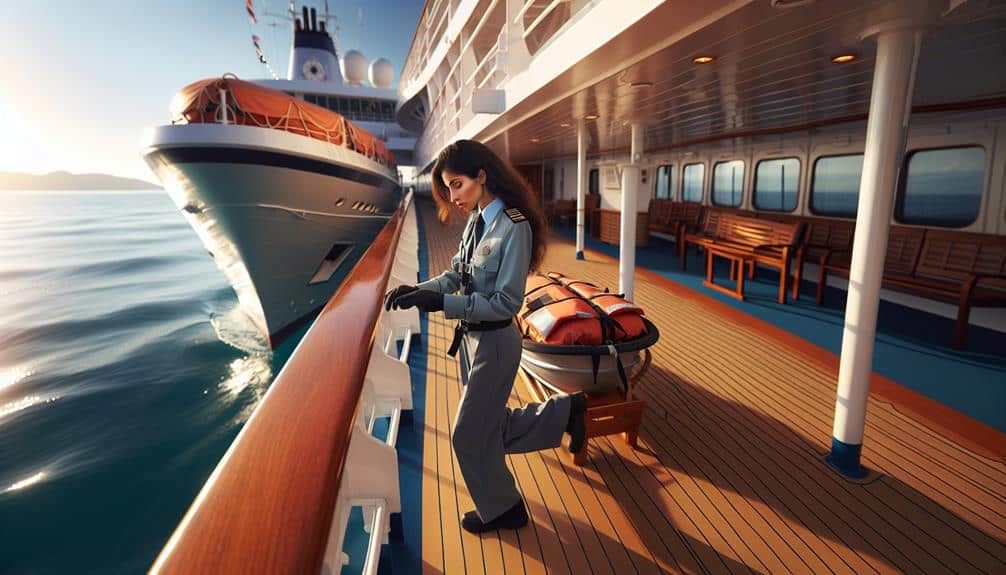To maintain cruise ship safety: First, monitor hull regularly, focusing on underwater part. Utilize advanced methods for corrosion detection. Second, examine safety equipment like life jackets and fire extinguishers. Ensure drills for crew are frequent. Third, inspect fire suppression system; check sensors, alarms, and sprinklers. Service regularly. Fourth, assess crew training, conduct simulations, and provide ongoing updates. Fifth, evaluate emergency drills, focusing on response times and coordination. These 5 inspection tips are essential to upholding high safety standards on board.
Key Points
- Perform thorough regular hull inspections using advanced techniques.
- Validate safety equipment readiness and conduct regular crew drills.
- Verify fire suppression system functionality and conduct maintenance checks.
- Assess crew training effectiveness through simulation exercises.
- Evaluate emergency drills to improve response times and passenger awareness.
Regular Hull Inspections
During routine maintenance checks, thoroughly inspect the cruise ship's hull for any signs of wear or damage. Start by focusing on the underwater hull, as it's vital for the vessel's integrity. Utilize advanced techniques for corrosion detection, such as magnetic particle testing or ultrasonic thickness gauging. Look for any areas where the protective paint coating may have worn off, exposing the metal to potential rusting. Pay special attention to weld seams, as they're often vulnerable points for corrosion to start. Use underwater cameras to get a clear view of areas that are hard to reach.
Ensure that all equipment used for these inspections is calibrated and functioning correctly. Record all findings meticulously, including photographs and videos if possible. Create a detailed report outlining the condition of the hull and any recommended actions for maintenance or repairs. Remember, a thorough inspection of the underwater hull is essential for ensuring the safety and longevity of the cruise ship.
Safety Equipment Checks
Conduct comprehensive checks of all safety equipment onboard the cruise ship to validate readiness for emergency situations. Safety equipment maintenance is vital to guarantee everything functions as intended during unforeseen events.
Start by inspecting life jackets to confirm they're in good condition, properly sized, and easily accessible. Check that life rafts are securely stored, inflated, and stocked with essential supplies. Verify that fire extinguishers aren't expired, easily reachable, and properly pressurized.
Emergency response training is key for crew members to efficiently handle safety equipment during crises. Regular drills should be conducted to practice using the equipment effectively.
Additionally, inspect emergency exits to ensure they're unobstructed and fully operational. By prioritizing safety equipment checks and maintenance, the cruise ship can enhance its preparedness for any emergency scenario, providing passengers with a secure and protected environment throughout their journey.
Fire Suppression System Examination
Verify the fire suppression system on the cruise ship undergoes a meticulous examination to confirm its functionality and readiness for addressing potential fire hazards. The fire suppression system is a critical component of fire safety on board, requiring regular maintenance and inspection to guarantee it operates effectively in case of an emergency. During the examination, all elements of the system must be thoroughly checked, including the fire detection sensors, alarm systems, sprinklers, and firefighting equipment.
Equipment maintenance plays a key role in the reliability of the fire suppression system. Technicians should inspect for any signs of wear and tear, corrosion, or malfunctioning parts that could compromise its performance. Regular testing and servicing are essential to keep the system in its prime working condition and ready to respond swiftly to any fire threat. By adhering to stringent inspection protocols and conducting routine maintenance, cruise ships can uphold high standards of fire safety and protect passengers and crew from potential risks.
Crew Training Assessment
To guarantee top safety standards onboard the cruise ship, a thorough assessment of crew training proficiency is essential. Evaluating the crew's training effectiveness and skill level ensures they're well-prepared to handle any emergencies that may arise during the voyage.
Here are some key aspects to take into account in the crew training assessment:
- Training Programs Review: Examine the content and structure of the training programs to verify they cover all necessary safety procedures and protocols.
- Simulation Exercises: Conduct regular simulation exercises to test the crew's response to different emergency scenarios and evaluate their performance.
- Skill Evaluation: Implement skill evaluation tests to assess the practical abilities of the crew members in using safety equipment and executing emergency procedures.
- Feedback Mechanism: Establish a feedback mechanism where crew members can provide insights on the training programs and suggest areas of improvement.
- Continual Training: Make sure that crew members receive ongoing training to stay updated on the latest safety protocols and regulations.
Emergency Drill Evaluation
Ensure the crew's readiness for emergencies by thoroughly evaluating the effectiveness of emergency drills conducted onboard the cruise ship. Evaluate drill effectiveness by analyzing response times, communication protocols, and coordination among crew members. Utilize scenario-based drills to simulate real-life emergencies and make sure that the crew can react promptly and efficiently.
Assess passenger awareness during emergency drills by monitoring their understanding of emergency procedures, evacuation routes, and muster station locations. Encourage active participation from passengers to familiarize themselves with safety protocols and enhance their preparedness in case of an actual emergency.
Review the feedback collected from both crew members and passengers after each drill to identify areas for improvement. Implement corrective measures based on the evaluation results to enhance the overall effectiveness of emergency preparedness onboard the cruise ship. Regularly conduct mock drills to reinforce training and continuously enhance the crew's ability to respond effectively to emergencies.
Frequently Asked Questions
How Often Are Routine Maintenance Inspections Conducted on Cruise Ships Outside of Regular Hull Inspections?
Maintenance inspections on cruise ships, excluding regular hull checks, are usually carried out on a quarterly basis. As a passenger, your duty is to report any safety concerns promptly to the crew to guarantee the ship's ongoing safety standards.
Are There Any Specific Safety Equipment Checks That Passengers Can Perform on Their Own to Ensure Their Own Safety on a Cruise Ship?
To guarantee your safety on a cruise ship, take responsibility as a passenger by conducting safety equipment checks. Inspect life jackets for wear, locate emergency exits, test smoke detectors, check fire extinguishers, and familiarize yourself with evacuation procedures.
What Measures Are in Place to Prevent Fires From Starting on a Cruise Ship in the First Place?
To prevent fires on a cruise ship, safety measures include regular maintenance of electrical systems, fire detection systems, and training crew on fire prevention. Safety equipment like fire extinguishers, sprinkler systems, and emergency drills further enhance preparedness and response capabilities.
How Often Are Crew Members Required to Undergo Training and Certification for Emergency Situations?
You should guarantee crew members undergo training regularly to meet certification requirements for emergency situations. Training frequency varies but typically occurs annually or biannually, covering drills, first aid, evacuation procedures, and more to maintain preparedness.
Are There Any Specific Emergency Drill Scenarios That Are Practiced More Frequently Than Others on Cruise Ships?
During emergency drills on cruise ships, specific scenarios like fire, man overboard, and abandon ship are practiced more frequently. Passenger participation in these drills guarantees readiness for potential emergencies, enhancing safety protocols and response efficiency.




